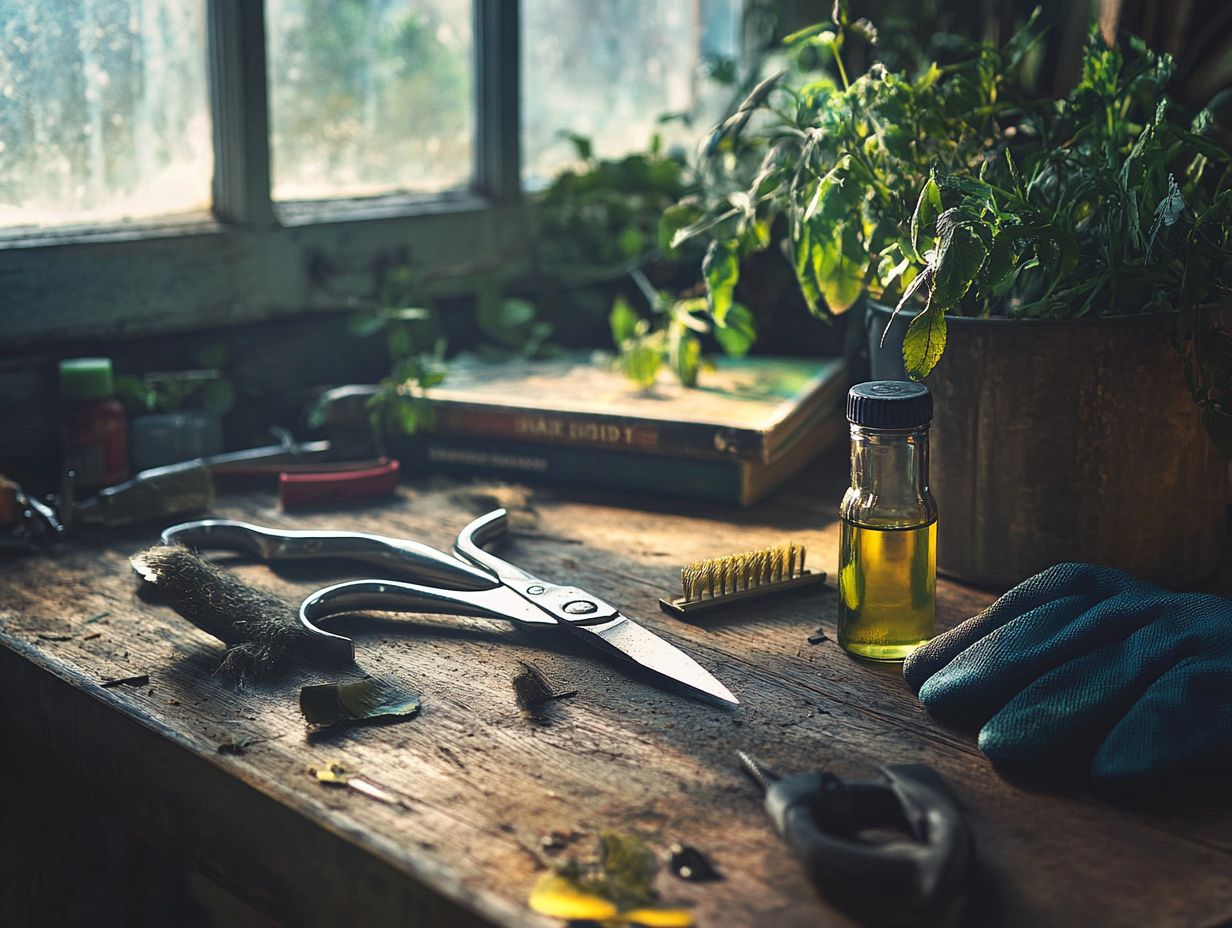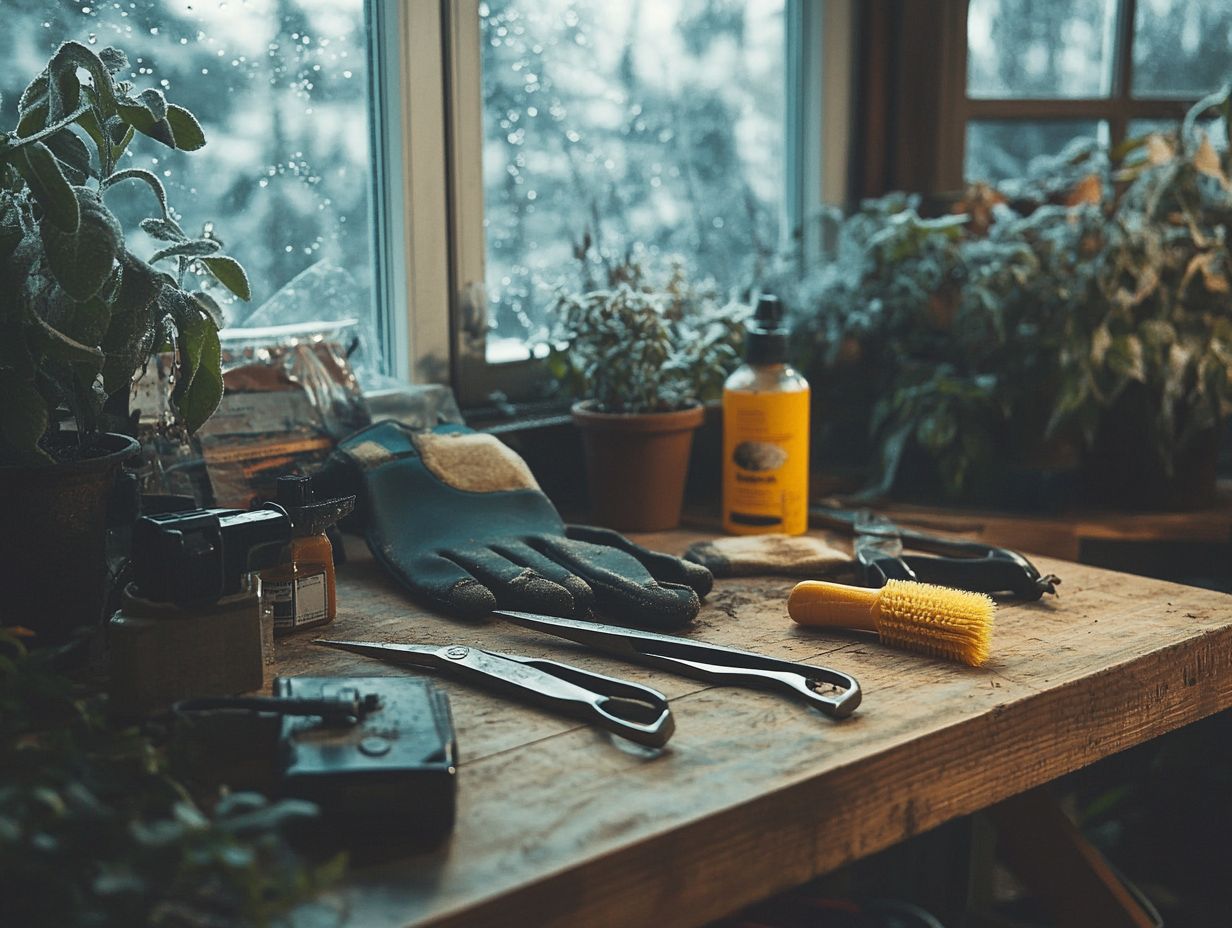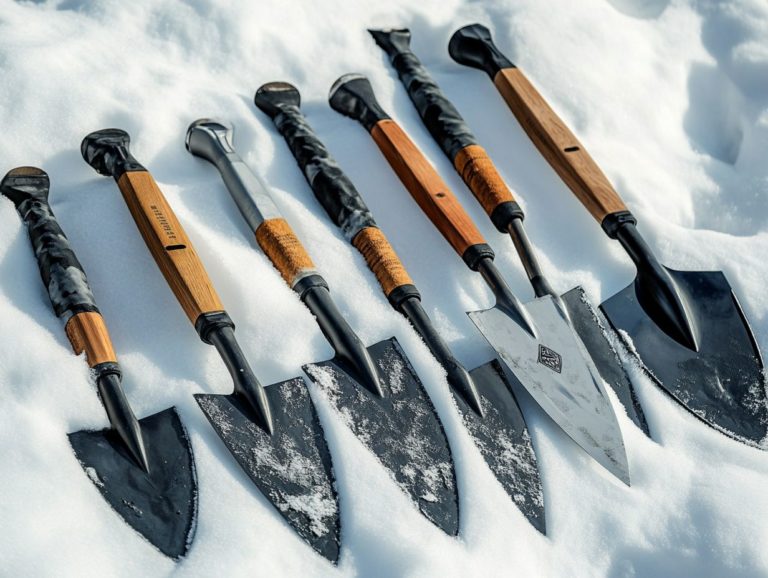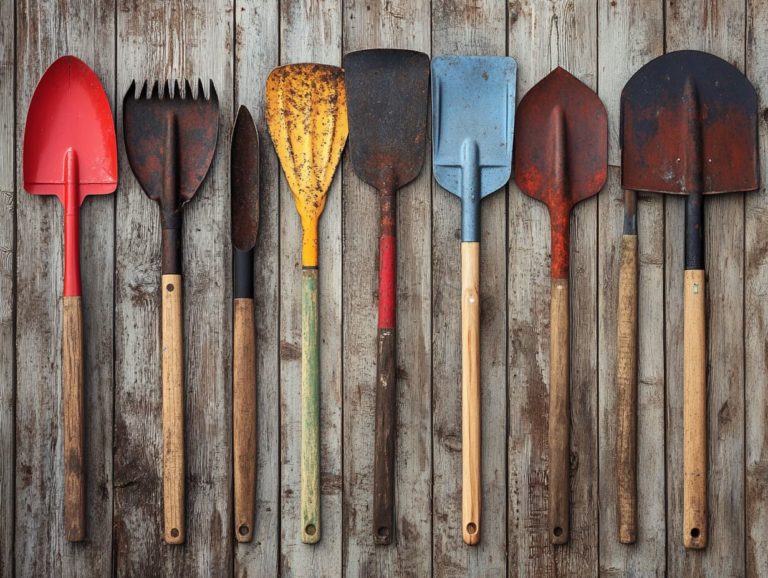How to Maintain Your Gardening Tools in Winter
As winter approaches, it’s crucial for you to give your gardening tools the attention they deserve. Proper maintenance, including regular cleaning and tool care, extends their lifespan and ensures they re primed for action when spring arrives.
This guide will lead you through the steps to effectively clean, sharpen, and store your tools, safeguarding them from the harsh winter elements. You ll also uncover valuable gardening tips on preventing rust and corrosion, ensuring your gardening essentials remain in peak condition for when you need them again.
Get excited! Here s how to keep your tools in top shape for winter!
Contents
- Key Takeaways:
- Preparing Your Gardening Tools for Winter
- Protecting Your Tools from Winter Elements
- Preventing Rust and Corrosion
- Additional Tips for Winter Tool Maintenance
- Frequently Asked Questions
- What are some ways to maintain my gardening tools in winter?
- How should I store my gardening tools during the winter months?
- Can I still use my gardening tools in winter?
- What should I do if my gardening tools have rusted?
- Do I need to sharpen my gardening tools in winter?
- What other maintenance tasks should I do for my gardening tools in winter?
Key Takeaways:

- Clean and store your gardening tools properly to prevent damage and rust this winter.
- Protect your tools from winter elements by using covers and storing them in a dry place.
- To prevent rust and corrosion, remove any moisture and apply rust inhibitors to your tools. Regularly check and replace worn parts to maintain their effectiveness.
Preparing Your Gardening Tools for Winter
As winter draws near, it’s vital to prepare your gardening tools for the chilly months ahead. Following some winter gardening tool maintenance tips keeps your tools in top shape and ensures you’re ready to tackle gardening tasks with ease come spring.
From cleaning and disinfecting your equipment to employing effective storage techniques, every step plays a crucial role in preserving the integrity of your essential gardening gear. By taking these proactive measures now, you ll position yourself for a thriving gardening season when the warm weather returns and the remnants of winter fade away.
Cleaning and Storing Tools
Cleaning and storing your garden tools properly is essential for maintaining their functionality and longevity. Start by thoroughly cleaning your tools with suitable substances like vinegar or specialized cleaning wipes.
Once you ve achieved that pristine shine, it s crucial to disinfect your tools to eliminate any lingering germs that could impact your garden when you bring them back into action. Use containers that keep water out for proper storage to shield your tools from the harsh winter elements.
You can elevate the care of these tools by applying motor oil or WD-40 to lubricate any hinged or moving parts. This will help prevent rust and ensure smooth operation when the gardening season returns.
After cleaning and lubricating, it s vital to follow best practices for storing your tools. Hang them on wall-mounted racks to keep them off the ground, minimizing moisture exposure.
- Placing silica gel packets in your storage containers can effectively absorb excess humidity, warding off rust and corrosion.
By disinfecting your tools thoroughly and following meticulous storage techniques, you can prevent cross-contamination in your garden, fostering a healthier and more productive environment for your plants.
Sharpening and Maintaining Blades
Sharpening and maintaining the blades of your garden tools is a crucial step in ensuring their efficiency and longevity throughout the winter months. Regular maintenance, especially for tools like pruners and hoes, allows for clean cuts and enhances your ability to tackle garden tasks with ease. Additionally, knowing how to manage weeds in winter gardens can further optimize your gardening efforts.
A wire brush can effectively eliminate rust, while linseed oil acts as a protective coating, extending the life of both wooden handles and metal components. By dedicating time to the proper sharpening and care of your tools, you prepare them for action when the gardening season rolls back around.
Beyond pruners and hoes, tools like shears and spades also significantly benefit from periodic sharpening and maintenance. The right sharpening technique could involve a whetstone or a diamond file, both of which help maintain the blade’s edge and optimize performance.
For rust removal, consider using methods like white vinegar or a baking soda paste before applying protective oils such as mineral oil or, again, linseed oil. Keeping your tools clean and well-oiled not only prevents deterioration but also minimizes the risk of injury during use, ensuring that every gardening task is completed with both ease and precision.
Protecting Your Tools from Winter Elements

Protecting your gardening tools from the harsh winter elements is crucial to keep them working well and to prolong their lifespan. To understand why using quality tools is vital, especially during the winter months, check out the importance of quality garden tools in winter, as the cold can introduce various threats, such as water and freezing temperatures, which can lead to rust and deterioration.
Protective coatings shield metal parts effectively. Using covers adds another layer of defense against the elements. Proper storage in a dry, temperate location enhances their longevity, especially during harsh winters, like those in Ohio.
Taking these precautions will ensure your tools remain in optimal condition, and you can also learn how to make your own cold-weather gardening tools, ready for the gardening season ahead.
Using Protective Coatings and Covers
Using protective coatings and covers is an excellent strategy for safeguarding your gardening tools during the harsh winter months.
The importance of applying adequate protective layers cannot be overstated; it directly affects the longevity and functionality of these essential implements. For instance, using a specialized spray that prevents rust on metal components displaces moisture, ensuring they remain rust-free.
When you coat your tools with a silicone-based lubricant, you repel water and enhance their maneuverability, making your gardening tasks smoother. Opt for heavy-duty tool covers made from waterproof fabrics to significantly minimize the risk of rust and erosion caused by the elements.
Use these tips to keep your gardening tools in top shape, including the top 10 must-have tools for winter gardening. They’ll be ready for planting season this spring!
Storing Tools in a Dry Location
Store your gardening tools in a dry location to prevent soil contamination and ensure they’re ready for action when the gardening season rolls around. To protect your tools and garden, learn how to winterize your garden, as a winter garden can introduce moisture and freezing temperatures, leading to fuel degradation and tool deterioration.
Choose a dry, climate-controlled area for your tool storage to effectively mitigate these risks and maintain the integrity of your equipment, ensuring they remain functional and effective.
Create a climate-controlled environment to keep moisture at bay! Monitor humidity and temperature to reduce the likelihood of rust and corrosion. It s wise to keep your tools off the ground use shelves or hooks to avoid contact with damp surfaces. Proper organization protects your tools and saves you valuable time.
When your tools are well-stored and easily accessible, it enhances your productivity in the garden and prolongs the lifespan of your gear, setting the stage for a fruitful gardening experience every season.
Preventing Rust and Corrosion
Preventing rust and corrosion is paramount in your tool care routine, especially as winter arrives and tools become more vulnerable to moisture. The winter garden environment can create perfect conditions for rust, making it essential to take proactive measures to safeguard your tools with effective care.
Regularly remove rust and apply vegetable oil on metal surfaces to significantly reduce the risk of corrosion. Implementing these strategies ensures your tools remain in peak condition, ready to support your gardening endeavors come spring.
Removing Moisture and Applying Rust Inhibitors

Removing moisture from gardening tools and applying products that prevent rust is essential for their winter functionality. Moisture can lead to rapid rust formation, damaging metal parts and diminishing their effectiveness.
Dry your tools thoroughly with a lint-free cloth. Then, apply a rust inhibitor like WD-40 to the metal surfaces for extra protection. This practice prevents rust and ensures your tools are ready for immediate use when spring arrives.
In addition to drying, remove any dirt or debris, as they can trap moisture against the metal surfaces. Once your tools are clean and dry, consider using specialized rust inhibitors oils or sprays tailored for specific materials like stainless steel or carbon steel. This targeted approach enhances the protective barrier and ensures maximum efficiency.
Regularly incorporating these steps into your tool maintenance routine is crucial for promoting longevity and reliability. Start now to save money and ensure your tools are ready for action!
Additional Tips for Winter Tool Maintenance
Along with cleaning and storing your tools, several tips for winter maintenance can elevate their performance and extend their lifespan. Embracing how to organize your gardening tools for winter reveals the best practices for caring for your tools during the colder months.
- Utilize cleaning wipes for routine upkeep.
- Apply vegetable oil to safeguard wooden handles.
By adopting these additional measures, you will ensure that your garden tools remain in superb condition, ready to spring back into action when the gardening season returns.
Properly Storing Small Hand Tools
Properly storing small hand tools is crucial for maintaining their effectiveness during winter. These tools, often tasked with delicate work, deserve special care to prevent rust and degradation.
Moisture and improper storage can lead to pesky rust buildup. By utilizing tool storage solutions like trays or magnetic strips, you not only keep your tools organized but also promote better air circulation, essential for warding off dampness.
Using cleaning wipes after each use serves a dual purpose: they eliminate dirt and grime while providing a protective layer that hinders rust formation. This simple step preserves the longevity and cleanliness of your essential tools, ensuring they remain reliable and efficient whenever you need them. It s also important to disinfect tools to prevent the spread of plant disease.
Checking and Replacing Worn Parts
Checking and replacing worn parts is an essential part of tool maintenance that you shouldn t overlook as winter approaches. Over time, components like blades, springs, and handles might show signs of wear and tear, impacting your tool’s performance.
Regular inspections allow you to remove rust in a timely manner and give you the chance to replace damaged parts before they become unusable. Keeping your tools in optimal condition enhances their effectiveness and promotes safe gardening practices.
Tool care goes beyond just replacing worn parts; frequent checks on those less visible components, like screws and pivot points, significantly affect functionality. Develop a routine inspection schedule ideally every few months to assess the condition of each tool and ensure you re using the right maintenance techniques.
When you spot signs of wear, such as dull blades or loose handles, promptly order replacement parts or consult a professional for guidance. Cleaning your tools after each use with a soft cloth and occasionally lubricating moving parts can greatly extend their lifespan, ensuring you re well-prepared for winter challenges.
Follow these steps to keep your tools in tip-top shape this winter!
Frequently Asked Questions

What are some ways to maintain my gardening tools in winter?
Clean your gardening tools after each use. Store them in a dry area to prevent rust.
How should I store my gardening tools during the winter months?
Keep your tools in a cool, dry place like a shed or garage. Remove dirt and debris before storing.
Can I still use my gardening tools in winter?
Yes, use your gardening tools in winter. Be sure to prepare your tools for spring gardening by cleaning and drying them thoroughly to avoid damage from moisture and cold.
What should I do if my gardening tools have rusted?
Remove rust using a wire brush or sandpaper. Soaking them in vinegar and water can help loosen rust.
Do I need to sharpen my gardening tools in winter?
You don’t need to sharpen your tools in winter, but check for dull or damaged blades. If necessary, sharpen them with a file or stone.
What other maintenance tasks should I do for my gardening tools in winter?
Check for loose or damaged parts and replace them if needed. Inspect handles for cracks or splinters and sand them down for safety.






